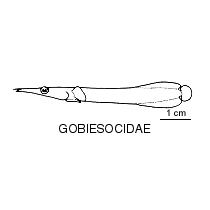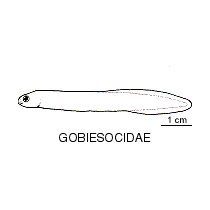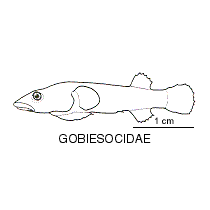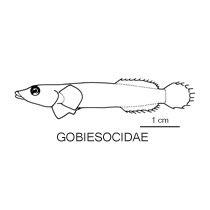- Classification
- ACTINOPTERYGII
- PERCIFORMES
- GOBIESOCIDAE
-
Fish Classification
-
Class
ACTINOPTERYGII Ray-finned fishes -
Order
PERCIFORMES Perches and allies -
Family
GOBIESOCIDAE Clingfishes
Family GOBIESOCIDAE
Mostly small cyptic, dorso-ventrally flattened fishes with a sucking disc on the underside. Most gobiesocids live in shallow seagrass and reef habitats, clinging to rocks, seagrass leaves, algae and sessile invertebrates. Some species live amongst the spines of sea urchins and crinoids, and a few act as cleaner fishes and cling to the bodies of larger fishes. Comprised of two groups with very different body forms: the clingfishes and the shore eels.
Clingfishes have a large, broad, flattened head, tapering to long, slender compressed body, and small dorsal and anal fins positioned far back near the tail. They lack scales and a swim bladder, but possess fin spines, and have pelvic fins modified into an obvious sucking disc on the underside of the body.
Shore eels are elongate, moderately-compressed, eel-like fishes with long-based dorsal and anal fins united with the tail, and a gill slit on the underside. They lack fin spines, pectoral fins, scales and a swim bladder, and their pelvic fins are either minute or absent. Shore-eels are only found in southern Australia and Norfolk Island.
Found worldwide in tropical and temperate waters. Most species live in shallow marine coastal waters where they cling to algae, seagrasses or invertebrates, or shelter under rocks and in crevices. A few species occur in freshwater. Some live below 200 m. Two Australian species act as cleaner fish, removing parasites from larger fishes.
More Info
|
Family Taxonomy |
Family with more than 160 species in two subfamilies. The Gobiesocinae contains most species, while the endemic Australian Cheilobranchinae contains 11 species, all in the genus Alabes. In Australia, 29 species in 11 genera are known. A number of species are yet to be described, including a one collected in 400 m off north Western Australia. |
|
Family Distribution |
Found worldwide in tropical and temperate marine environments, although more species live in temperate waters. Gobiesocids commonly inhabit seagrass, coral and rocky reef environments, from intertidal depths to 400 m. Some tropical species live on crinoids or amongst sea urchin spines. Shore eels are endemic to mainland Australia and Norfolk Island. |
|
Family Description |
Characterised by the sucking disc on the chest formed from the united pelvic fins and supported by highly modified pectoral and pelvic bones. The sucking disc is rudimentary or absent in Alabes. |
|
Family Size |
Small marine fishes, ranging in length from 1.5 to 30 cm. The largest Australian species reaches about 11 cm. |
|
Family Colour |
Well-camouflaged cryptic fishes, with colour patterns matching their surroundings. |
|
Family Feeding |
Gobiesocids are omnivores and feed on tiny benthic invertebrates, zooplanton and algae. Two Australian species act as cleaner fish, removing parasites from larger fishes. |
|
Family Reproduction |
The sexes are separate, fertilisation is external, and females lay demersal eggs that are attached to the substrate. At hatching, the larvae are well-developed and range in size from 2.4 to 6.8 mm. They have a small yolk sac, functional jaws, fully pigmented eyes and body pigmentation similar to that of post yolk-sac larvae (Leis & Rennis, 2000). |
|
Family Commercial |
A few species are traded in the aquarium industry. |
|
Family Conservation |
No Australian species are listed on the IUCN Red List. |
|
Author |
Dianne J. Bray |
References
Allen, G.R. 1997. Marine fishes of tropical Australia and south-east Asia. Western Australian Museum, Perth. 1-292.
Allen, G.R. & R.C. Steene. 1988. Fishes of Christmas Island Indian Ocean. Christmas Island Natural History Association, Christmas Island, Indian Ocean, 6798, Australia. 197 p.
Allen, L.G. 1984. Gobiesociformes: Development and relationships (pp. 629-636). In: H.G. Moser, W.J. Richards, D.M. Cohen, M.P. Fahay, A.W. Kendall, Jr., & S.L Richardson (eds.) Ontogeny and systematics of fishes. Spec. Publ. 1, Am. Soc. Ichthyol. Herpetol., Allen Press, Lawrence, KS, 760 p.
Briggs, J.C. 1955. A monograph of the clingfishes (order Xenopterygii). Stanford Ichthyological Bulletin 6: 1-224 figs 1-114
Briggs, J.C. 1993. New genus and species of clingfish (Gobiesocidae) from Southern Australia. Copeia 1993(1): 196-199.
Francis, M.P. 1993. Checklist of the coastal fishes of Lord Howe, Norfolk, and Kermadec Islands, Southwest Pacific Ocean. Pacific Science 47(2): 136-170
Hoese, D.F. & D.J. Bray. 2006. Gobiesocidae (pp. 1568-1576). In: Beesley, P.L. & Wells, A. (eds) 2006. Zoological Catalogue of Australia. Volume 35 Australia : ABRS & CSIRO Publishing Parts 1-3 2178 pp.
Hutchins, J.B. 1983. Redescription of the clingfish Cochleoceps spatula (Gobiesocidae) from Western Australia and South Australia, with the description of a new species from Victoria and Tasmania. Records of the Western Australian Museum 11(1): 33-47 figs 1-7
Hutchins, J.B. 1984. Description of a new gobiesocid fish from south-western Australia, with a key to the species of Aspasmogaster. Records of the Western Australian Museum 11(2): 129-140 figs 1-5
Hutchins, J.B. 1991. Description of a new deepwater clingfish (Gobiesocidae) from New South Wales. Records of the Western Australian Museum 15(2): 463-468.
Hutchins, J.B. 1991. Southern Australia's enigmatic clingfishes. Australian Natural History 23(8): 626-633.
Hutchins, J.B. 1991. Description of three new species of gobiesocid fishes from southern Australia, with a key to the species of Cochleoceps. Records of the Western Australian Museum 15(3): 655-672
Hutchins, J.B. 2001. Family Gobiesocidae (pp. 3547-3548). In: Carpenter, K.E. & Niem, T.H. (eds) 2001. The Living Marine Resources of the Western Central Pacific. FAO Species Identification Guide for Fisheries Purposes. Rome : FAO Vol. 6 pp. 3381-4218.
Hutchins, J.B. 2006. Description of two new species of shore-eels (Gobiesocidae: Cheilobranchinae: Alabes) from south-eastern Australia and Norfolk Island. Memoirs of Museum Victoria 63(1): 25-28.
Hutchins, J.B. 2008. Family Gobiesocidae (pp. 722-742). In: Gomon. M.F., Bray, D.J. & Kuiter, R.H (eds) 2008. Fishes of Australia's Southern Coast. Sydney : Reed New Holland 928 pp.
Hutchins, J.B. & S. Morrison. 2004. Five new species of the genus Alabes (Gobiesocidae: Cheilobranchinae). Records of the Australian Museum 56(2): 147-158.
Hutchins, J.B. & Swainston, R. 1986. Sea Fishes of Southern Australia. Complete field guide for anglers and divers. Perth : Swainston Publishing 180 pp.
Kuiter, R.H. 1993. Coastal Fishes of South-eastern Australia. Bathurst : Crawford House Press 437 p.
Kuiter, R.H. 1996. Guide to sea fishes of Australia. A comprehensive reference for divers and fishermen. Sydney, NSW, Australia : New Holland Publishers pp. I-xvii + 1-434.
Leis, J.M. & D.S. Rennis. 2000. Gobiesocidae (pp. 131-134). In: Leis, J.M. & Carson-Ewart, B.M. (eds) The larvae of Indo-Pacific coastal fishes. An identification guide to marine fish larvae. Fauna Malesiana Handbooks Leiden : Brill Vol. 2 870 pp.
Nelson, J.S. 2006. Fishes of the World. Hoboken, New Jersey : John Wiley & Sons, Inc. 601 pp.
Randall, J.E., G.R. Allen & R.C. Steene. 1997. Fishes of the Great Barrier Reef and Coral Sea. 2nd Ed. Crawford House Publishing Pty Ltd. Bathurst, NSW, Australia. 557 p.
Springer, V.G. & Fraser, T.H. 1976. Synonymy of the fish families Cheilobranchidae (=Alabetidae) and Gobiesocidae, with descriptions of two new species of Alabes. Smithsonian Contributions to Zoology 234: 1-23 figs 1-14














































































































































































































































